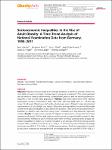Socioeconomic Inequalities in the Rise of Adult Obesity: A Time-Trend Analysis of National Examination Data from Germany, 1990–2011
Hoebel, J.
Kuntz, B.
Kroll, L. E.
Schienkiewitz, A.
Finger, J. D.
Lange, C.
Lampert, T.
Objective: Despite extensive study of the obesity epidemic, research on whether obesity has risen faster in lower or in higher socioeconomic groups is inconsistent. This study examined secular trends in obesity prevalence by socioeconomic position and the resulting obesity inequalities in the German adult population. Methods: Data were drawn from three national examination surveys conducted in 1990–1992, 1997–1999 and 2008–2011 (n = 18,541; age range: 25–69 years). Obesity was defined by a body mass index ≥30 kg/m2 using standardised measurements of body height and weight. Education and equivalised household disposable income were used as indicators of socioeconomic position. Time trends in socioeconomic inequalities in obesity were examined using linear probability and log-binomial regression models. Results: In each survey period, the highest socioeconomic groups had the lowest prevalence of obesity. The low and medium socioeconomic groups showed increases in obesity prevalence, whereas no such trend was observed in the high socioeconomic groups. Absolute inequalities in obesity by income increased by an average of 0.53 percentage points per year (95% confidence interval [CI] 0.01–1.05, p = 0.047) among men and 0.47 percentage points per year (95% CI 0.05–0.90, p = 0.029) among women. Absolute inequalities in obesity by education increased on average by 0.64 percentage points per year (95% CI 0.19–1.08, p = 0.005) among women but not among men (0.33 percentage points, 95% CI –0.27 to 0.92, p = 0.283). Conclusions: These findings suggest a widening obesity gap between the top and the bottom of the socioeconomic spectrum. This has the potential to have adverse consequences for population health and health inequalities in coming decades. Interventions that are effective in preventing and reducing obesity in socially disadvantaged groups are needed.

